Here at DeVooght House Lifters, we’ve worked with hundreds of homeowners who ask, “Now that my house is elevated, what maintenance should I do to keep it protected?” We’re glad you asked! This guide will walk you through everything from foundation checks to proper ventilation to ensure your elevated home remains secure against flooding.
1. Regular Foundation Inspections
Why It Matters
Your foundation is literally the bedrock of your home’s structural integrity, and when your house is elevated, the foundation carries even more responsibility for keeping everything stable. Minor cracks or shifts might not seem like a big deal at first, but over time, they can lead to significant damage.
What to Do
- Visual Checks: At least once every six months, walk around the perimeter of your home to look for cracks or signs of settling.
- Hire a Pro: If you spot anything suspicious—crumbling concrete, fissures that seem to be expanding—contact a foundation specialist or give us a call.
- Record Keeping: Take photos of any cracks and note their size and location. This helps track changes over time and can be invaluable if you ever need professional assistance.
2. Maintain Proper Ventilation
Why It’s Crucial
Elevated homes often include enclosed or partially enclosed spaces beneath the living area. While these spaces are great for storage (or even a garage), they’re also more vulnerable to moisture. Adequate ventilation ensures that any humidity or floodwater that makes its way in can dry out quickly, preventing mold, rot, and other costly problems.
Key Tips
- Flood Vents: Ensure that your flood vents remain unobstructed. These are specifically designed to allow floodwaters to flow in and out, reducing pressure on your foundation walls.
- Mechanical Ventilation: Consider installing fans or vents in enclosed areas, especially if you live in a humid climate like many regions in the Southeast.
- Check for Blockages: Twice a year, clear away debris, leaves, or dirt from vents to keep airflow consistent.
3. Keep an Eye on Drainage
The Role of Gutters and Downspouts
Gutters and downspouts direct water away from your home, which is especially important if you’re in a region prone to heavy rainfall or hurricanes. When water accumulates around the foundation, it increases the risk of seepage and can undermine the soil that supports your home.
Maintenance Steps
- Clean Gutters: Remove leaves, twigs, and other debris at least twice a year—more if you have overhanging trees.
- Extend Downspouts: Make sure your downspouts release water at least three to four feet away from the foundation. Extensions or splash blocks can help direct water away from your elevated structure.
- Grading: The soil around your home should slope away from the foundation. Re-grade if necessary to ensure water doesn’t pool.
4. Pest and Rodent Control
The Hidden Danger
Elevated homes often have additional crawlspaces or enclosed areas that can become cozy hiding spots for rodents, insects, and other pests. Not only can they damage structural elements, but some pests—like termites—can wreak havoc on wooden beams that support your elevated home.
Prevention Tactics
- Seal Gaps: Look for openings around utility lines, vents, and doors. Seal these cracks or gaps with weatherproof caulk or foam.
- Regular Pest Inspections: Set up an annual check with a licensed pest control professional to ensure you don’t have unwanted guests.
- Proper Storage: Avoid storing cardboard boxes or paper goods directly on the ground beneath your house, as these attract insects.
5. Protecting Utilities and Equipment
Why It Matters
When your home is lifted, your utility lines, HVAC units, and other equipment might be more exposed. Even if you’ve elevated your HVAC system, you’ll want to ensure it’s secure, properly maintained, and protected from the elements.
Practical Tips
- Raise Mechanical Systems: If you haven’t already, consider elevating your HVAC units and electrical panels above the Base Flood Elevation (BFE).
- Secure Fuel Tanks: In flood-prone areas, unanchored fuel tanks can break away, causing dangerous spills and property damage. Anchor them to a concrete slab or a sturdy support frame.
- Routine Service: Schedule annual or biannual servicing for HVAC units and water heaters. Maintenance not only prolongs the life of your equipment, but also ensures it remains in top working condition in the event of a flood.
6. Plan for Emergencies
It’s Not All About the House
Even with an elevated home, floods can sometimes surpass expected levels. Having an emergency plan is crucial for your safety and peace of mind.
Key Actions
- Emergency Kit: Stock essential supplies like bottled water, non-perishable food, flashlights, and a first-aid kit.
- Evacuation Routes: Know your local routes and the nearest shelters in case flooding forces you to leave.
- Insurance Updates: Review your flood insurance policy every year. Even if your risks are lower, changes in FEMA maps or local conditions could alter your coverage needs.
7. Call DeVooght House Lifters for Help
Here at DeVooght House Lifters, we don’t just lift homes—we’re committed to helping you maintain and protect them. If you have any questions about the stability of your elevated foundation, the condition of your flood vents, or you’re considering additional measures like raising mechanical systems, we’re just a phone call away. We have the experience and expertise to guide you through every step of safeguarding your investment.
Conclusion
Elevating your home is a significant project that brings major peace of mind, especially in flood-prone areas. But remember: an elevated home still requires diligent maintenance to preserve its benefits. From foundational checks to ventilation to pest control, each small step adds up to keep your property safe, dry, and structurally sound.
By following these tips and staying proactive, you’ll be well on your way to enjoying the many advantages of an elevated home. And if you ever need professional guidance or spot something that concerns you, reach out to us at DeVooght House Lifters. We’re here to help you every step of the way.

